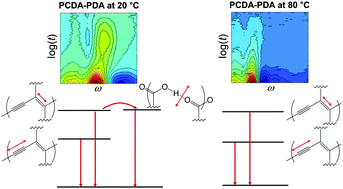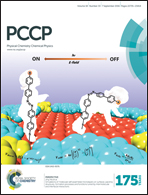Electronic relaxation dynamics of PCDA-PDA studied by transient absorption spectroscopy†
Abstract
Photo-curable polymers originating from 10,12-pentacosadiynoic acid (PCDA-PDA) are commonly used polydiacetylenes (PDAs). PCDA-PDA exhibits thermochromic properties undergoing a unique colorimetric transition from blue to red as the temperature is increased from low to high. In this work, we have carefully studied the temperature-dependent optical properties of PCDA-PDA by using UV-visible absorption, FTIR, Raman, and transient absorption (TA) spectroscopy in combination with quantum chemical calculations. Temperature-dependent UV-visible absorption spectra indicate that PCDA-PDA exhibits reversible thermochromic properties up to 60 °C and its thermochromic properties become irreversible above 60 °C. Such distinct thermochromic properties are also manifested in TA signals so that the electronically excited PCDA-PDA relaxes to the ground state via an intermediate state at 20 °C (blue form) but it relaxes directly back to the ground state at 80 °C (red form). The electronic relaxation dynamics of PCDA-PDA are comprehensively analyzed based on different kinetic models by using the global fitting analysis method. The intermediate state in the blue form of PCDA-PDA is clearly found to be responsible for fluorescence quenching. FTIR and Raman spectroscopy and quantum chemical calculations confirm that the H-bonds between the carboxylic acid groups in PCDA-PDA are broken at high temperatures leading to an irreversible structural change of PCDA-PDA.


 Please wait while we load your content...
Please wait while we load your content...